Dissertation: Social Media's Role in Nepal Tourism Development
VerifiedAdded on 2020/10/23
|10
|2993
|369
Thesis and Dissertation
AI Summary
This dissertation investigates the effectiveness of social media in promoting Nepal as a tourist destination. It examines the current state of Nepal's tourism, highlighting challenges such as infrastructural limitations, inadequate entertainment, and safety concerns. The study explores the government's use of social media platforms like Facebook and analyzes the factors considered for effective promotion. The research questions address the key elements that the government considers for effective utilization of social media and the challenges faced in promoting Nepal. The methodology includes an inductive research approach, a descriptive research design, and primary data collection through questionnaires with Nepalese experts. The findings aim to identify the best ways to utilize social media to boost tourism, offering insights for policymakers and future research. The study also acknowledges limitations such as time constraints and financial restrictions.
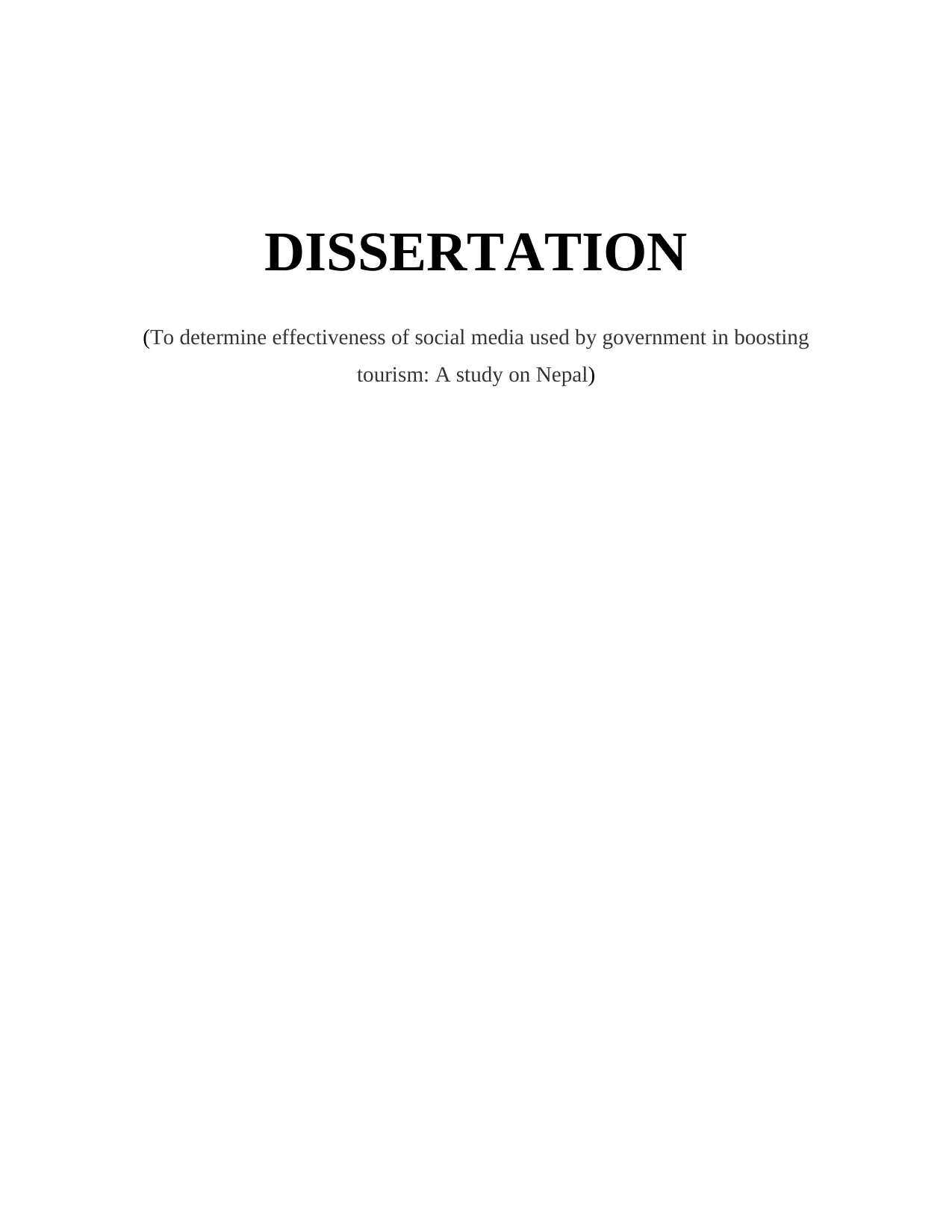
DISSERTATION
(To determine effectiveness of social media used by government in boosting
tourism: A study on Nepal)
(To determine effectiveness of social media used by government in boosting
tourism: A study on Nepal)
Paraphrase This Document
Need a fresh take? Get an instant paraphrase of this document with our AI Paraphraser
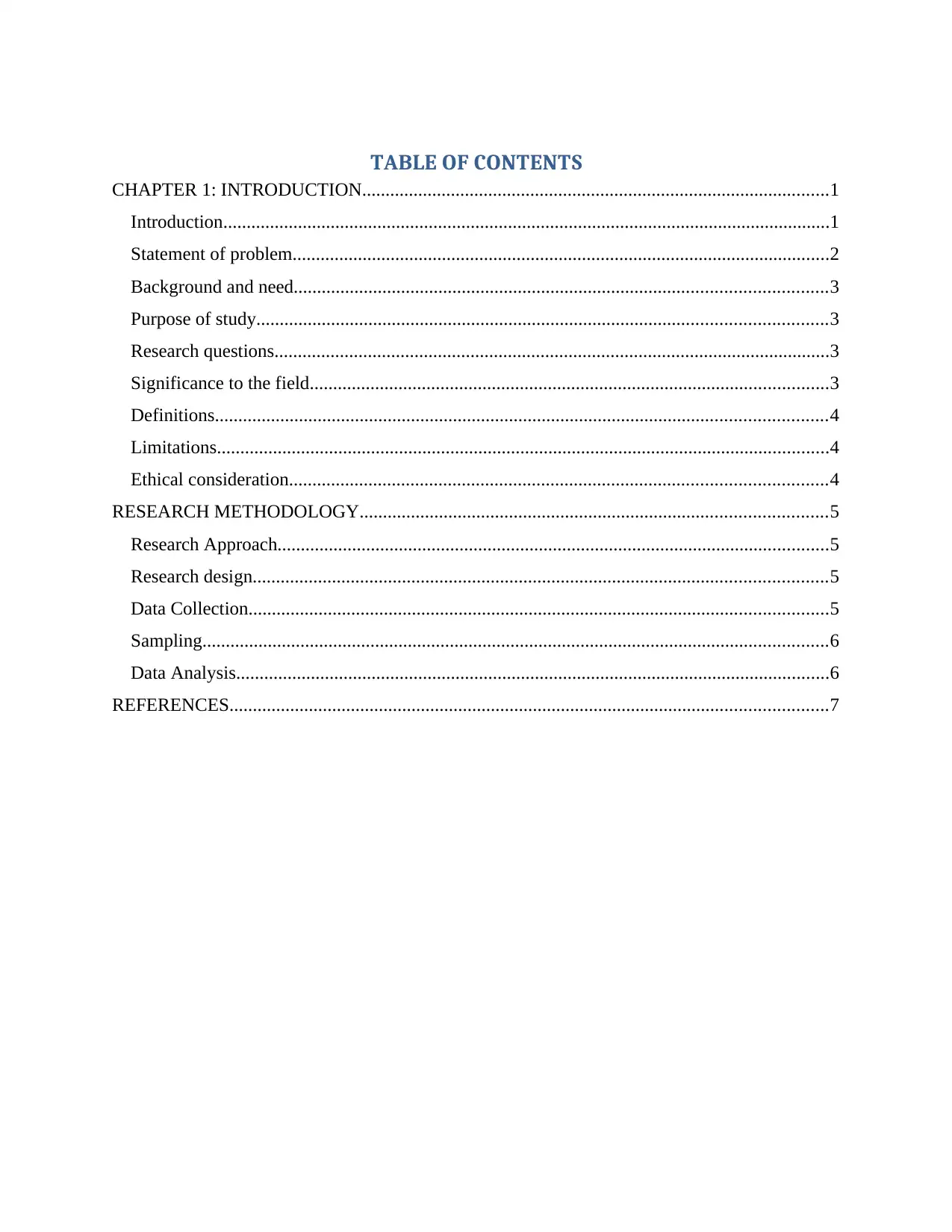
TABLE OF CONTENTS
CHAPTER 1: INTRODUCTION....................................................................................................1
Introduction..................................................................................................................................1
Statement of problem...................................................................................................................2
Background and need..................................................................................................................3
Purpose of study..........................................................................................................................3
Research questions.......................................................................................................................3
Significance to the field...............................................................................................................3
Definitions...................................................................................................................................4
Limitations...................................................................................................................................4
Ethical consideration...................................................................................................................4
RESEARCH METHODOLOGY....................................................................................................5
Research Approach......................................................................................................................5
Research design...........................................................................................................................5
Data Collection............................................................................................................................5
Sampling......................................................................................................................................6
Data Analysis...............................................................................................................................6
REFERENCES................................................................................................................................7
CHAPTER 1: INTRODUCTION....................................................................................................1
Introduction..................................................................................................................................1
Statement of problem...................................................................................................................2
Background and need..................................................................................................................3
Purpose of study..........................................................................................................................3
Research questions.......................................................................................................................3
Significance to the field...............................................................................................................3
Definitions...................................................................................................................................4
Limitations...................................................................................................................................4
Ethical consideration...................................................................................................................4
RESEARCH METHODOLOGY....................................................................................................5
Research Approach......................................................................................................................5
Research design...........................................................................................................................5
Data Collection............................................................................................................................5
Sampling......................................................................................................................................6
Data Analysis...............................................................................................................................6
REFERENCES................................................................................................................................7
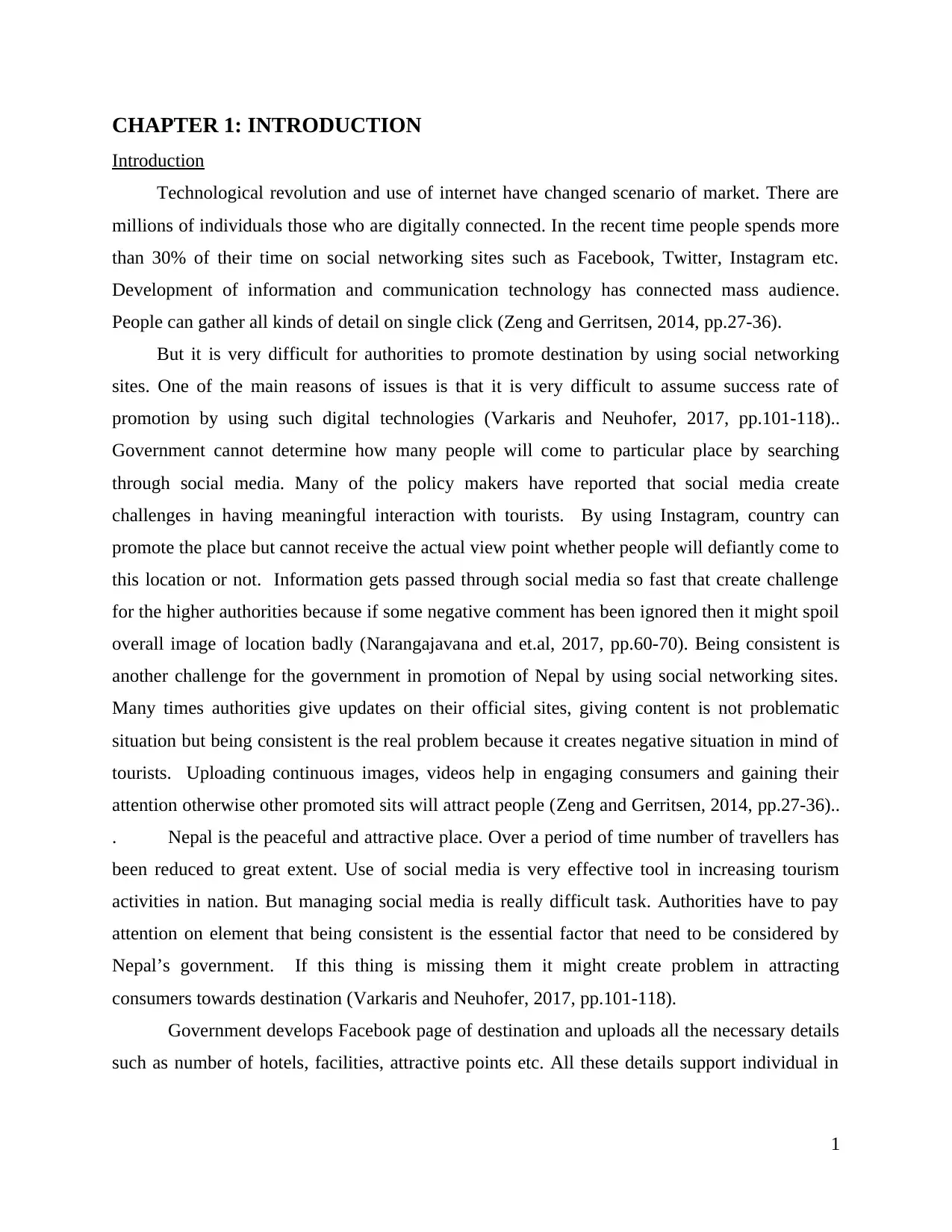
CHAPTER 1: INTRODUCTION
Introduction
Technological revolution and use of internet have changed scenario of market. There are
millions of individuals those who are digitally connected. In the recent time people spends more
than 30% of their time on social networking sites such as Facebook, Twitter, Instagram etc.
Development of information and communication technology has connected mass audience.
People can gather all kinds of detail on single click (Zeng and Gerritsen, 2014, pp.27-36).
But it is very difficult for authorities to promote destination by using social networking
sites. One of the main reasons of issues is that it is very difficult to assume success rate of
promotion by using such digital technologies (Varkaris and Neuhofer, 2017, pp.101-118)..
Government cannot determine how many people will come to particular place by searching
through social media. Many of the policy makers have reported that social media create
challenges in having meaningful interaction with tourists. By using Instagram, country can
promote the place but cannot receive the actual view point whether people will defiantly come to
this location or not. Information gets passed through social media so fast that create challenge
for the higher authorities because if some negative comment has been ignored then it might spoil
overall image of location badly (Narangajavana and et.al, 2017, pp.60-70). Being consistent is
another challenge for the government in promotion of Nepal by using social networking sites.
Many times authorities give updates on their official sites, giving content is not problematic
situation but being consistent is the real problem because it creates negative situation in mind of
tourists. Uploading continuous images, videos help in engaging consumers and gaining their
attention otherwise other promoted sits will attract people (Zeng and Gerritsen, 2014, pp.27-36)..
. Nepal is the peaceful and attractive place. Over a period of time number of travellers has
been reduced to great extent. Use of social media is very effective tool in increasing tourism
activities in nation. But managing social media is really difficult task. Authorities have to pay
attention on element that being consistent is the essential factor that need to be considered by
Nepal’s government. If this thing is missing them it might create problem in attracting
consumers towards destination (Varkaris and Neuhofer, 2017, pp.101-118).
Government develops Facebook page of destination and uploads all the necessary details
such as number of hotels, facilities, attractive points etc. All these details support individual in
1
Introduction
Technological revolution and use of internet have changed scenario of market. There are
millions of individuals those who are digitally connected. In the recent time people spends more
than 30% of their time on social networking sites such as Facebook, Twitter, Instagram etc.
Development of information and communication technology has connected mass audience.
People can gather all kinds of detail on single click (Zeng and Gerritsen, 2014, pp.27-36).
But it is very difficult for authorities to promote destination by using social networking
sites. One of the main reasons of issues is that it is very difficult to assume success rate of
promotion by using such digital technologies (Varkaris and Neuhofer, 2017, pp.101-118)..
Government cannot determine how many people will come to particular place by searching
through social media. Many of the policy makers have reported that social media create
challenges in having meaningful interaction with tourists. By using Instagram, country can
promote the place but cannot receive the actual view point whether people will defiantly come to
this location or not. Information gets passed through social media so fast that create challenge
for the higher authorities because if some negative comment has been ignored then it might spoil
overall image of location badly (Narangajavana and et.al, 2017, pp.60-70). Being consistent is
another challenge for the government in promotion of Nepal by using social networking sites.
Many times authorities give updates on their official sites, giving content is not problematic
situation but being consistent is the real problem because it creates negative situation in mind of
tourists. Uploading continuous images, videos help in engaging consumers and gaining their
attention otherwise other promoted sits will attract people (Zeng and Gerritsen, 2014, pp.27-36)..
. Nepal is the peaceful and attractive place. Over a period of time number of travellers has
been reduced to great extent. Use of social media is very effective tool in increasing tourism
activities in nation. But managing social media is really difficult task. Authorities have to pay
attention on element that being consistent is the essential factor that need to be considered by
Nepal’s government. If this thing is missing them it might create problem in attracting
consumers towards destination (Varkaris and Neuhofer, 2017, pp.101-118).
Government develops Facebook page of destination and uploads all the necessary details
such as number of hotels, facilities, attractive points etc. All these details support individual in
1
⊘ This is a preview!⊘
Do you want full access?
Subscribe today to unlock all pages.

Trusted by 1+ million students worldwide
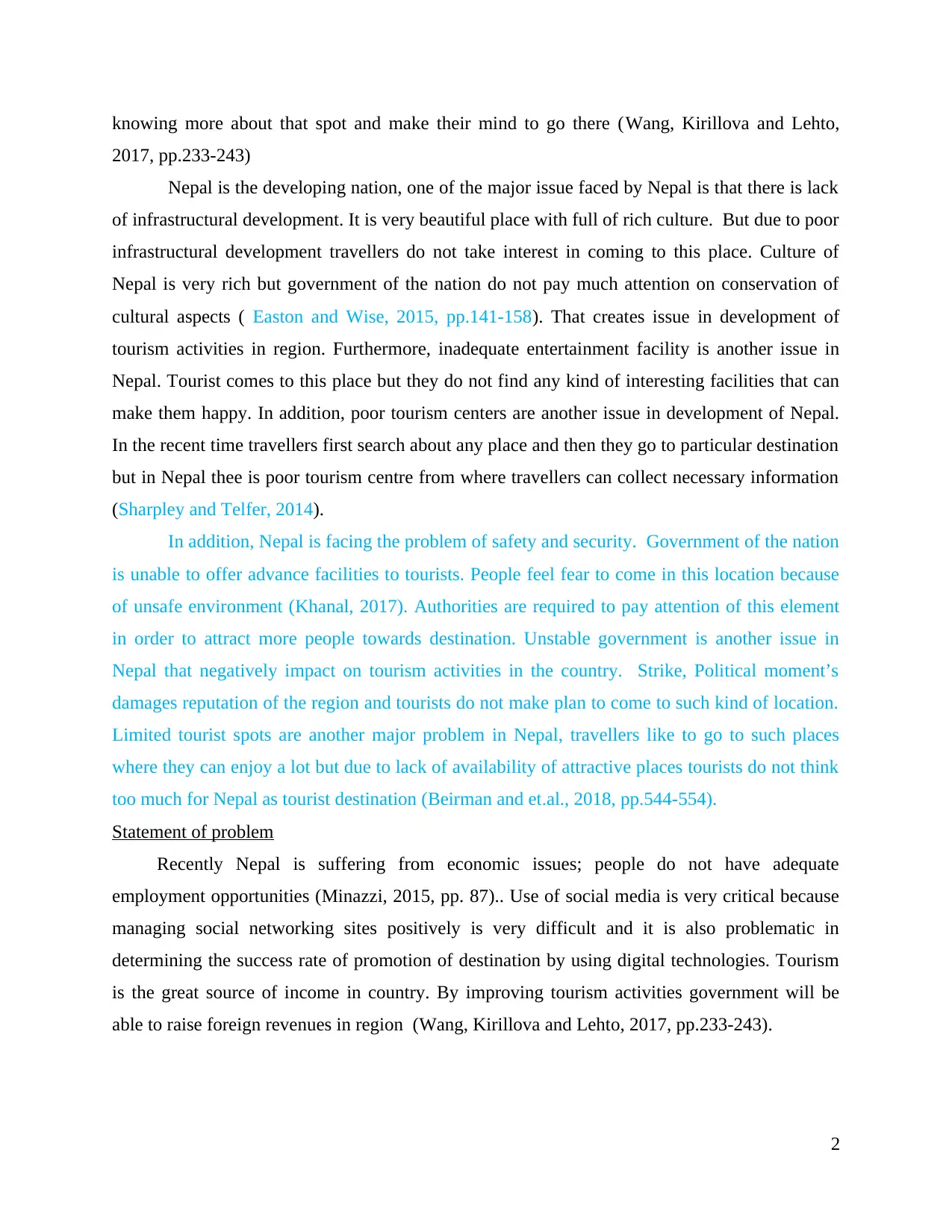
knowing more about that spot and make their mind to go there (Wang, Kirillova and Lehto,
2017, pp.233-243)
Nepal is the developing nation, one of the major issue faced by Nepal is that there is lack
of infrastructural development. It is very beautiful place with full of rich culture. But due to poor
infrastructural development travellers do not take interest in coming to this place. Culture of
Nepal is very rich but government of the nation do not pay much attention on conservation of
cultural aspects ( Easton and Wise, 2015, pp.141-158). That creates issue in development of
tourism activities in region. Furthermore, inadequate entertainment facility is another issue in
Nepal. Tourist comes to this place but they do not find any kind of interesting facilities that can
make them happy. In addition, poor tourism centers are another issue in development of Nepal.
In the recent time travellers first search about any place and then they go to particular destination
but in Nepal thee is poor tourism centre from where travellers can collect necessary information
(Sharpley and Telfer, 2014).
In addition, Nepal is facing the problem of safety and security. Government of the nation
is unable to offer advance facilities to tourists. People feel fear to come in this location because
of unsafe environment (Khanal, 2017). Authorities are required to pay attention of this element
in order to attract more people towards destination. Unstable government is another issue in
Nepal that negatively impact on tourism activities in the country. Strike, Political moment’s
damages reputation of the region and tourists do not make plan to come to such kind of location.
Limited tourist spots are another major problem in Nepal, travellers like to go to such places
where they can enjoy a lot but due to lack of availability of attractive places tourists do not think
too much for Nepal as tourist destination (Beirman and et.al., 2018, pp.544-554).
Statement of problem
Recently Nepal is suffering from economic issues; people do not have adequate
employment opportunities (Minazzi, 2015, pp. 87).. Use of social media is very critical because
managing social networking sites positively is very difficult and it is also problematic in
determining the success rate of promotion of destination by using digital technologies. Tourism
is the great source of income in country. By improving tourism activities government will be
able to raise foreign revenues in region (Wang, Kirillova and Lehto, 2017, pp.233-243).
2
2017, pp.233-243)
Nepal is the developing nation, one of the major issue faced by Nepal is that there is lack
of infrastructural development. It is very beautiful place with full of rich culture. But due to poor
infrastructural development travellers do not take interest in coming to this place. Culture of
Nepal is very rich but government of the nation do not pay much attention on conservation of
cultural aspects ( Easton and Wise, 2015, pp.141-158). That creates issue in development of
tourism activities in region. Furthermore, inadequate entertainment facility is another issue in
Nepal. Tourist comes to this place but they do not find any kind of interesting facilities that can
make them happy. In addition, poor tourism centers are another issue in development of Nepal.
In the recent time travellers first search about any place and then they go to particular destination
but in Nepal thee is poor tourism centre from where travellers can collect necessary information
(Sharpley and Telfer, 2014).
In addition, Nepal is facing the problem of safety and security. Government of the nation
is unable to offer advance facilities to tourists. People feel fear to come in this location because
of unsafe environment (Khanal, 2017). Authorities are required to pay attention of this element
in order to attract more people towards destination. Unstable government is another issue in
Nepal that negatively impact on tourism activities in the country. Strike, Political moment’s
damages reputation of the region and tourists do not make plan to come to such kind of location.
Limited tourist spots are another major problem in Nepal, travellers like to go to such places
where they can enjoy a lot but due to lack of availability of attractive places tourists do not think
too much for Nepal as tourist destination (Beirman and et.al., 2018, pp.544-554).
Statement of problem
Recently Nepal is suffering from economic issues; people do not have adequate
employment opportunities (Minazzi, 2015, pp. 87).. Use of social media is very critical because
managing social networking sites positively is very difficult and it is also problematic in
determining the success rate of promotion of destination by using digital technologies. Tourism
is the great source of income in country. By improving tourism activities government will be
able to raise foreign revenues in region (Wang, Kirillova and Lehto, 2017, pp.233-243).
2
Paraphrase This Document
Need a fresh take? Get an instant paraphrase of this document with our AI Paraphraser
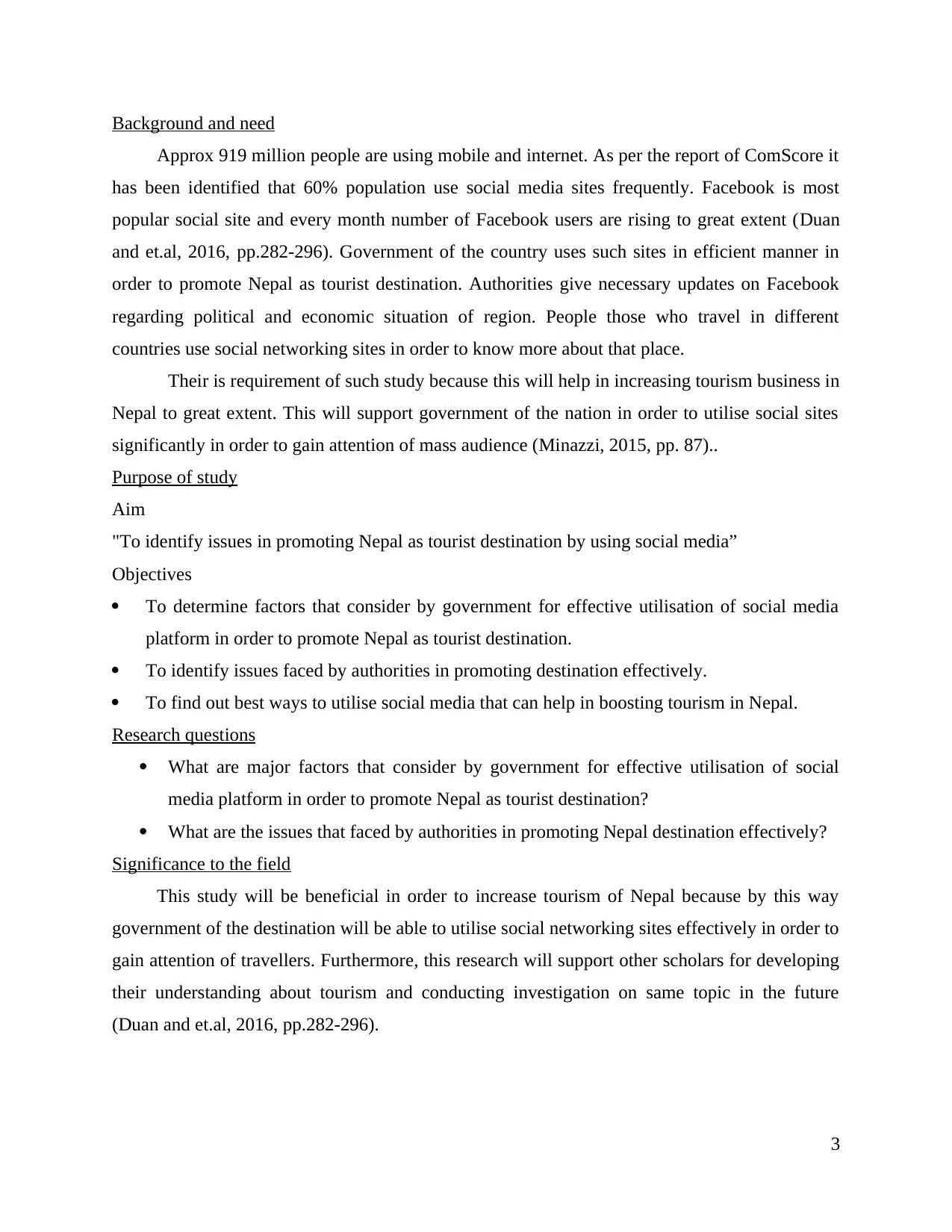
Background and need
Approx 919 million people are using mobile and internet. As per the report of ComScore it
has been identified that 60% population use social media sites frequently. Facebook is most
popular social site and every month number of Facebook users are rising to great extent (Duan
and et.al, 2016, pp.282-296). Government of the country uses such sites in efficient manner in
order to promote Nepal as tourist destination. Authorities give necessary updates on Facebook
regarding political and economic situation of region. People those who travel in different
countries use social networking sites in order to know more about that place.
Their is requirement of such study because this will help in increasing tourism business in
Nepal to great extent. This will support government of the nation in order to utilise social sites
significantly in order to gain attention of mass audience (Minazzi, 2015, pp. 87)..
Purpose of study
Aim
"To identify issues in promoting Nepal as tourist destination by using social media”
Objectives
To determine factors that consider by government for effective utilisation of social media
platform in order to promote Nepal as tourist destination.
To identify issues faced by authorities in promoting destination effectively.
To find out best ways to utilise social media that can help in boosting tourism in Nepal.
Research questions
What are major factors that consider by government for effective utilisation of social
media platform in order to promote Nepal as tourist destination?
What are the issues that faced by authorities in promoting Nepal destination effectively?
Significance to the field
This study will be beneficial in order to increase tourism of Nepal because by this way
government of the destination will be able to utilise social networking sites effectively in order to
gain attention of travellers. Furthermore, this research will support other scholars for developing
their understanding about tourism and conducting investigation on same topic in the future
(Duan and et.al, 2016, pp.282-296).
3
Approx 919 million people are using mobile and internet. As per the report of ComScore it
has been identified that 60% population use social media sites frequently. Facebook is most
popular social site and every month number of Facebook users are rising to great extent (Duan
and et.al, 2016, pp.282-296). Government of the country uses such sites in efficient manner in
order to promote Nepal as tourist destination. Authorities give necessary updates on Facebook
regarding political and economic situation of region. People those who travel in different
countries use social networking sites in order to know more about that place.
Their is requirement of such study because this will help in increasing tourism business in
Nepal to great extent. This will support government of the nation in order to utilise social sites
significantly in order to gain attention of mass audience (Minazzi, 2015, pp. 87)..
Purpose of study
Aim
"To identify issues in promoting Nepal as tourist destination by using social media”
Objectives
To determine factors that consider by government for effective utilisation of social media
platform in order to promote Nepal as tourist destination.
To identify issues faced by authorities in promoting destination effectively.
To find out best ways to utilise social media that can help in boosting tourism in Nepal.
Research questions
What are major factors that consider by government for effective utilisation of social
media platform in order to promote Nepal as tourist destination?
What are the issues that faced by authorities in promoting Nepal destination effectively?
Significance to the field
This study will be beneficial in order to increase tourism of Nepal because by this way
government of the destination will be able to utilise social networking sites effectively in order to
gain attention of travellers. Furthermore, this research will support other scholars for developing
their understanding about tourism and conducting investigation on same topic in the future
(Duan and et.al, 2016, pp.282-296).
3
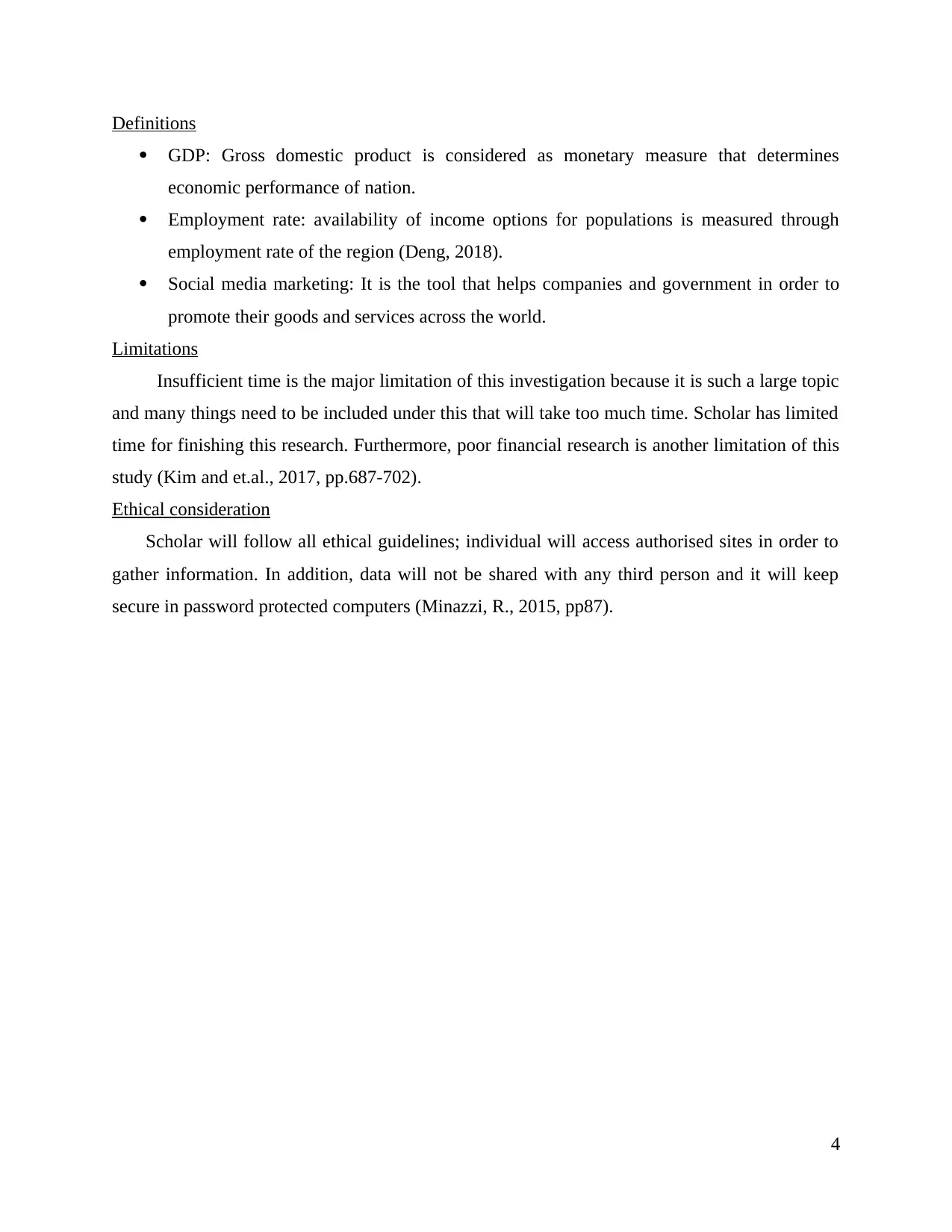
Definitions
GDP: Gross domestic product is considered as monetary measure that determines
economic performance of nation.
Employment rate: availability of income options for populations is measured through
employment rate of the region (Deng, 2018).
Social media marketing: It is the tool that helps companies and government in order to
promote their goods and services across the world.
Limitations
Insufficient time is the major limitation of this investigation because it is such a large topic
and many things need to be included under this that will take too much time. Scholar has limited
time for finishing this research. Furthermore, poor financial research is another limitation of this
study (Kim and et.al., 2017, pp.687-702).
Ethical consideration
Scholar will follow all ethical guidelines; individual will access authorised sites in order to
gather information. In addition, data will not be shared with any third person and it will keep
secure in password protected computers (Minazzi, R., 2015, pp87).
4
GDP: Gross domestic product is considered as monetary measure that determines
economic performance of nation.
Employment rate: availability of income options for populations is measured through
employment rate of the region (Deng, 2018).
Social media marketing: It is the tool that helps companies and government in order to
promote their goods and services across the world.
Limitations
Insufficient time is the major limitation of this investigation because it is such a large topic
and many things need to be included under this that will take too much time. Scholar has limited
time for finishing this research. Furthermore, poor financial research is another limitation of this
study (Kim and et.al., 2017, pp.687-702).
Ethical consideration
Scholar will follow all ethical guidelines; individual will access authorised sites in order to
gather information. In addition, data will not be shared with any third person and it will keep
secure in password protected computers (Minazzi, R., 2015, pp87).
4
⊘ This is a preview!⊘
Do you want full access?
Subscribe today to unlock all pages.

Trusted by 1+ million students worldwide
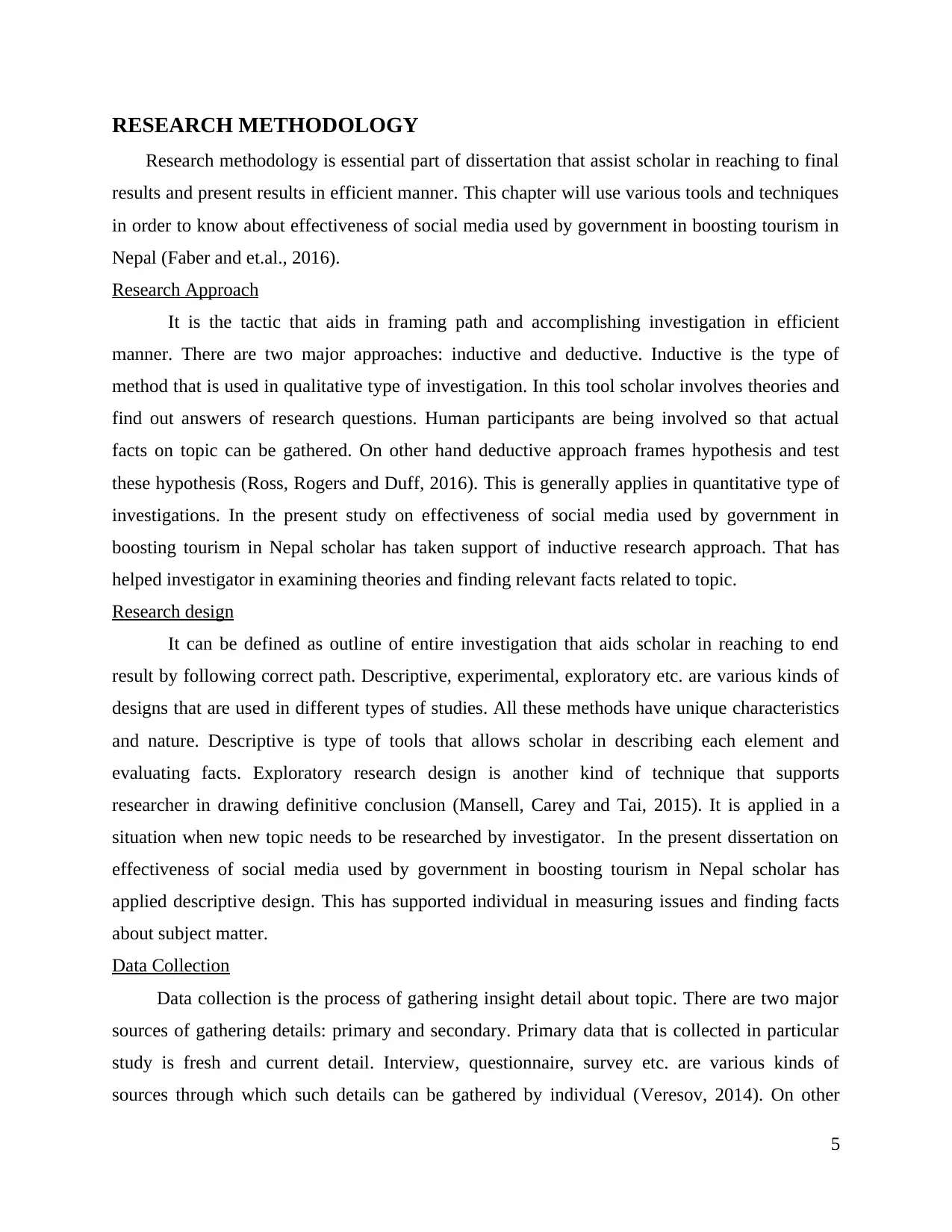
RESEARCH METHODOLOGY
Research methodology is essential part of dissertation that assist scholar in reaching to final
results and present results in efficient manner. This chapter will use various tools and techniques
in order to know about effectiveness of social media used by government in boosting tourism in
Nepal (Faber and et.al., 2016).
Research Approach
It is the tactic that aids in framing path and accomplishing investigation in efficient
manner. There are two major approaches: inductive and deductive. Inductive is the type of
method that is used in qualitative type of investigation. In this tool scholar involves theories and
find out answers of research questions. Human participants are being involved so that actual
facts on topic can be gathered. On other hand deductive approach frames hypothesis and test
these hypothesis (Ross, Rogers and Duff, 2016). This is generally applies in quantitative type of
investigations. In the present study on effectiveness of social media used by government in
boosting tourism in Nepal scholar has taken support of inductive research approach. That has
helped investigator in examining theories and finding relevant facts related to topic.
Research design
It can be defined as outline of entire investigation that aids scholar in reaching to end
result by following correct path. Descriptive, experimental, exploratory etc. are various kinds of
designs that are used in different types of studies. All these methods have unique characteristics
and nature. Descriptive is type of tools that allows scholar in describing each element and
evaluating facts. Exploratory research design is another kind of technique that supports
researcher in drawing definitive conclusion (Mansell, Carey and Tai, 2015). It is applied in a
situation when new topic needs to be researched by investigator. In the present dissertation on
effectiveness of social media used by government in boosting tourism in Nepal scholar has
applied descriptive design. This has supported individual in measuring issues and finding facts
about subject matter.
Data Collection
Data collection is the process of gathering insight detail about topic. There are two major
sources of gathering details: primary and secondary. Primary data that is collected in particular
study is fresh and current detail. Interview, questionnaire, survey etc. are various kinds of
sources through which such details can be gathered by individual (Veresov, 2014). On other
5
Research methodology is essential part of dissertation that assist scholar in reaching to final
results and present results in efficient manner. This chapter will use various tools and techniques
in order to know about effectiveness of social media used by government in boosting tourism in
Nepal (Faber and et.al., 2016).
Research Approach
It is the tactic that aids in framing path and accomplishing investigation in efficient
manner. There are two major approaches: inductive and deductive. Inductive is the type of
method that is used in qualitative type of investigation. In this tool scholar involves theories and
find out answers of research questions. Human participants are being involved so that actual
facts on topic can be gathered. On other hand deductive approach frames hypothesis and test
these hypothesis (Ross, Rogers and Duff, 2016). This is generally applies in quantitative type of
investigations. In the present study on effectiveness of social media used by government in
boosting tourism in Nepal scholar has taken support of inductive research approach. That has
helped investigator in examining theories and finding relevant facts related to topic.
Research design
It can be defined as outline of entire investigation that aids scholar in reaching to end
result by following correct path. Descriptive, experimental, exploratory etc. are various kinds of
designs that are used in different types of studies. All these methods have unique characteristics
and nature. Descriptive is type of tools that allows scholar in describing each element and
evaluating facts. Exploratory research design is another kind of technique that supports
researcher in drawing definitive conclusion (Mansell, Carey and Tai, 2015). It is applied in a
situation when new topic needs to be researched by investigator. In the present dissertation on
effectiveness of social media used by government in boosting tourism in Nepal scholar has
applied descriptive design. This has supported individual in measuring issues and finding facts
about subject matter.
Data Collection
Data collection is the process of gathering insight detail about topic. There are two major
sources of gathering details: primary and secondary. Primary data that is collected in particular
study is fresh and current detail. Interview, questionnaire, survey etc. are various kinds of
sources through which such details can be gathered by individual (Veresov, 2014). On other
5
Paraphrase This Document
Need a fresh take? Get an instant paraphrase of this document with our AI Paraphraser
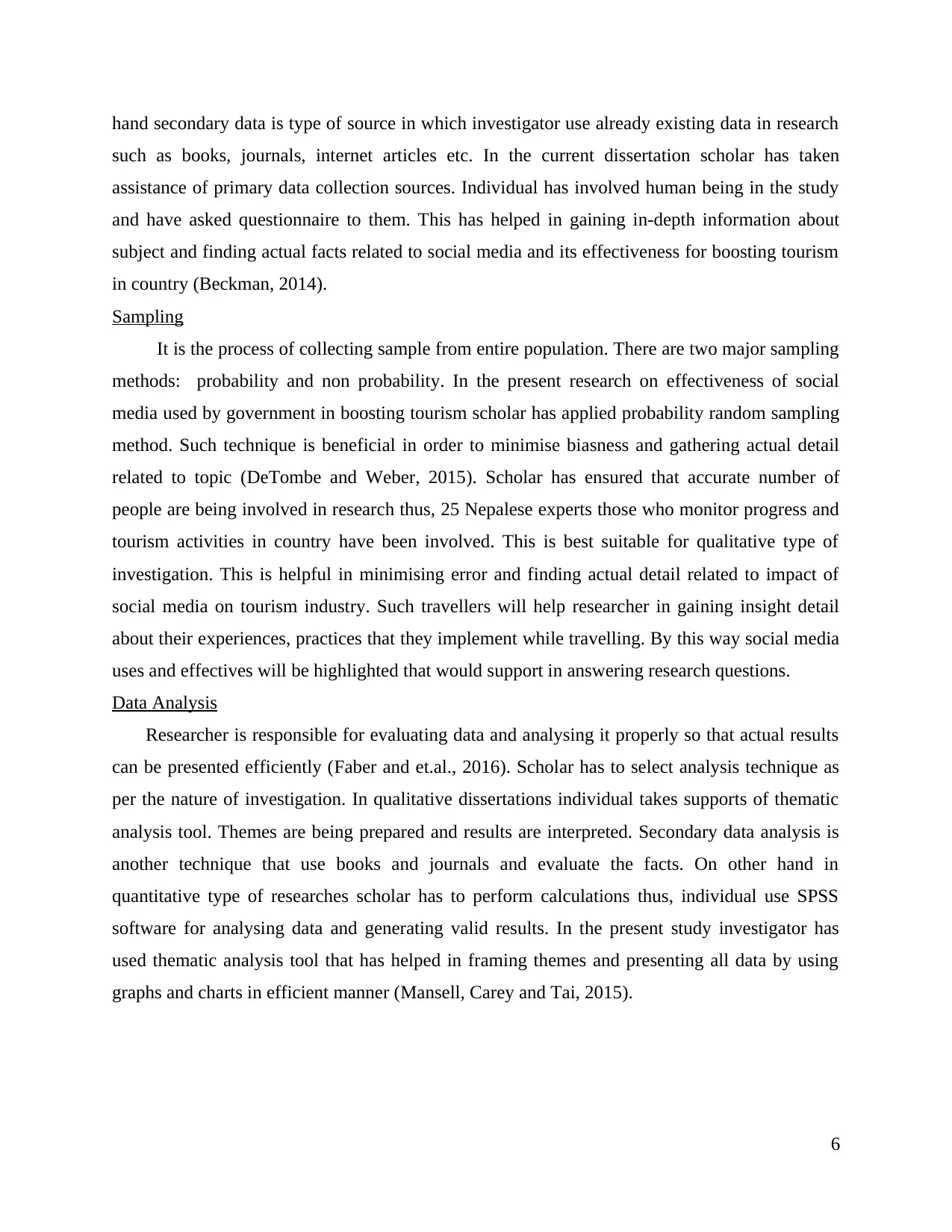
hand secondary data is type of source in which investigator use already existing data in research
such as books, journals, internet articles etc. In the current dissertation scholar has taken
assistance of primary data collection sources. Individual has involved human being in the study
and have asked questionnaire to them. This has helped in gaining in-depth information about
subject and finding actual facts related to social media and its effectiveness for boosting tourism
in country (Beckman, 2014).
Sampling
It is the process of collecting sample from entire population. There are two major sampling
methods: probability and non probability. In the present research on effectiveness of social
media used by government in boosting tourism scholar has applied probability random sampling
method. Such technique is beneficial in order to minimise biasness and gathering actual detail
related to topic (DeTombe and Weber, 2015). Scholar has ensured that accurate number of
people are being involved in research thus, 25 Nepalese experts those who monitor progress and
tourism activities in country have been involved. This is best suitable for qualitative type of
investigation. This is helpful in minimising error and finding actual detail related to impact of
social media on tourism industry. Such travellers will help researcher in gaining insight detail
about their experiences, practices that they implement while travelling. By this way social media
uses and effectives will be highlighted that would support in answering research questions.
Data Analysis
Researcher is responsible for evaluating data and analysing it properly so that actual results
can be presented efficiently (Faber and et.al., 2016). Scholar has to select analysis technique as
per the nature of investigation. In qualitative dissertations individual takes supports of thematic
analysis tool. Themes are being prepared and results are interpreted. Secondary data analysis is
another technique that use books and journals and evaluate the facts. On other hand in
quantitative type of researches scholar has to perform calculations thus, individual use SPSS
software for analysing data and generating valid results. In the present study investigator has
used thematic analysis tool that has helped in framing themes and presenting all data by using
graphs and charts in efficient manner (Mansell, Carey and Tai, 2015).
6
such as books, journals, internet articles etc. In the current dissertation scholar has taken
assistance of primary data collection sources. Individual has involved human being in the study
and have asked questionnaire to them. This has helped in gaining in-depth information about
subject and finding actual facts related to social media and its effectiveness for boosting tourism
in country (Beckman, 2014).
Sampling
It is the process of collecting sample from entire population. There are two major sampling
methods: probability and non probability. In the present research on effectiveness of social
media used by government in boosting tourism scholar has applied probability random sampling
method. Such technique is beneficial in order to minimise biasness and gathering actual detail
related to topic (DeTombe and Weber, 2015). Scholar has ensured that accurate number of
people are being involved in research thus, 25 Nepalese experts those who monitor progress and
tourism activities in country have been involved. This is best suitable for qualitative type of
investigation. This is helpful in minimising error and finding actual detail related to impact of
social media on tourism industry. Such travellers will help researcher in gaining insight detail
about their experiences, practices that they implement while travelling. By this way social media
uses and effectives will be highlighted that would support in answering research questions.
Data Analysis
Researcher is responsible for evaluating data and analysing it properly so that actual results
can be presented efficiently (Faber and et.al., 2016). Scholar has to select analysis technique as
per the nature of investigation. In qualitative dissertations individual takes supports of thematic
analysis tool. Themes are being prepared and results are interpreted. Secondary data analysis is
another technique that use books and journals and evaluate the facts. On other hand in
quantitative type of researches scholar has to perform calculations thus, individual use SPSS
software for analysing data and generating valid results. In the present study investigator has
used thematic analysis tool that has helped in framing themes and presenting all data by using
graphs and charts in efficient manner (Mansell, Carey and Tai, 2015).
6
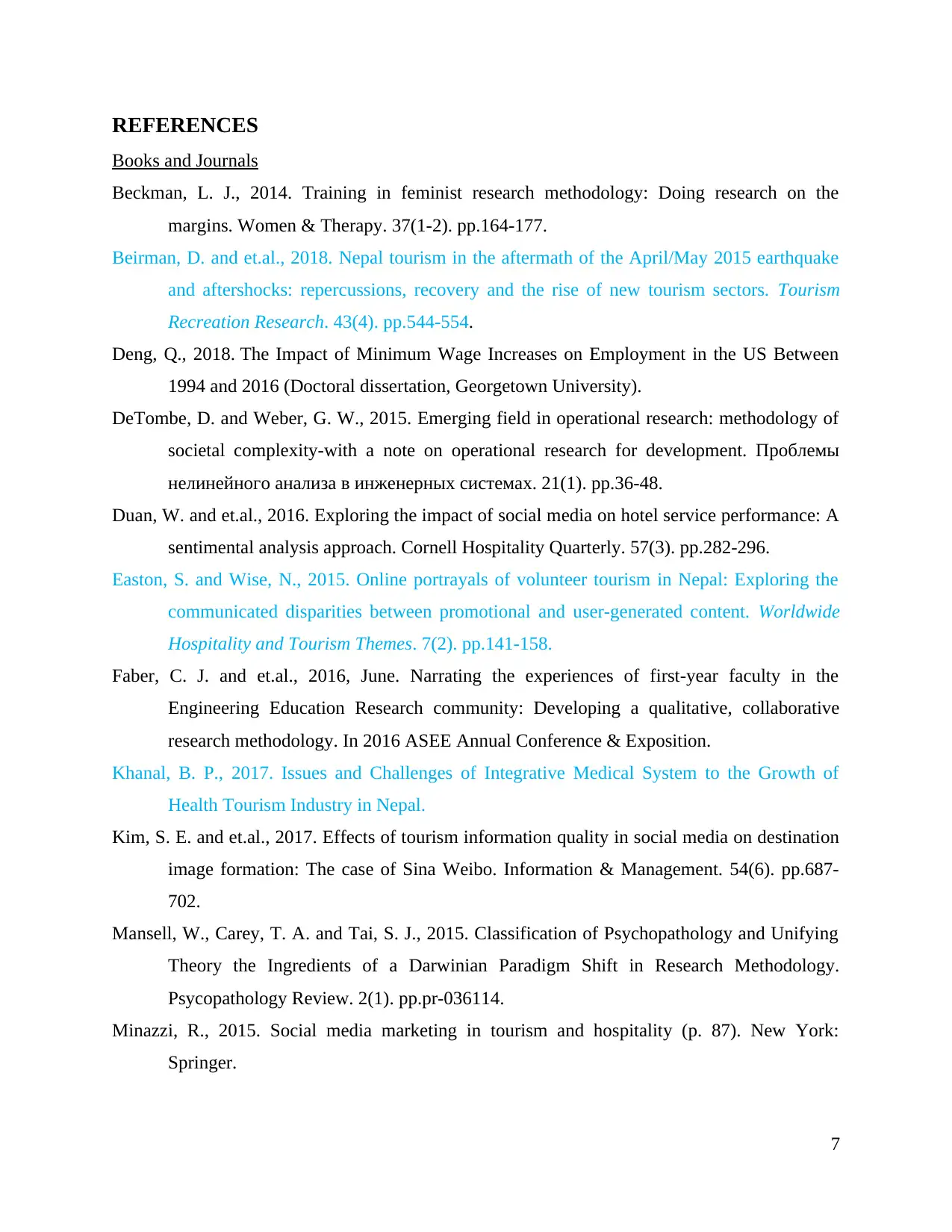
REFERENCES
Books and Journals
Beckman, L. J., 2014. Training in feminist research methodology: Doing research on the
margins. Women & Therapy. 37(1-2). pp.164-177.
Beirman, D. and et.al., 2018. Nepal tourism in the aftermath of the April/May 2015 earthquake
and aftershocks: repercussions, recovery and the rise of new tourism sectors. Tourism
Recreation Research. 43(4). pp.544-554.
Deng, Q., 2018. The Impact of Minimum Wage Increases on Employment in the US Between
1994 and 2016 (Doctoral dissertation, Georgetown University).
DeTombe, D. and Weber, G. W., 2015. Emerging field in operational research: methodology of
societal complexity-with a note on operational research for development. Проблемы
нелинейного анализа в инженерных системах. 21(1). pp.36-48.
Duan, W. and et.al., 2016. Exploring the impact of social media on hotel service performance: A
sentimental analysis approach. Cornell Hospitality Quarterly. 57(3). pp.282-296.
Easton, S. and Wise, N., 2015. Online portrayals of volunteer tourism in Nepal: Exploring the
communicated disparities between promotional and user-generated content. Worldwide
Hospitality and Tourism Themes. 7(2). pp.141-158.
Faber, C. J. and et.al., 2016, June. Narrating the experiences of first-year faculty in the
Engineering Education Research community: Developing a qualitative, collaborative
research methodology. In 2016 ASEE Annual Conference & Exposition.
Khanal, B. P., 2017. Issues and Challenges of Integrative Medical System to the Growth of
Health Tourism Industry in Nepal.
Kim, S. E. and et.al., 2017. Effects of tourism information quality in social media on destination
image formation: The case of Sina Weibo. Information & Management. 54(6). pp.687-
702.
Mansell, W., Carey, T. A. and Tai, S. J., 2015. Classification of Psychopathology and Unifying
Theory the Ingredients of a Darwinian Paradigm Shift in Research Methodology.
Psycopathology Review. 2(1). pp.pr-036114.
Minazzi, R., 2015. Social media marketing in tourism and hospitality (p. 87). New York:
Springer.
7
Books and Journals
Beckman, L. J., 2014. Training in feminist research methodology: Doing research on the
margins. Women & Therapy. 37(1-2). pp.164-177.
Beirman, D. and et.al., 2018. Nepal tourism in the aftermath of the April/May 2015 earthquake
and aftershocks: repercussions, recovery and the rise of new tourism sectors. Tourism
Recreation Research. 43(4). pp.544-554.
Deng, Q., 2018. The Impact of Minimum Wage Increases on Employment in the US Between
1994 and 2016 (Doctoral dissertation, Georgetown University).
DeTombe, D. and Weber, G. W., 2015. Emerging field in operational research: methodology of
societal complexity-with a note on operational research for development. Проблемы
нелинейного анализа в инженерных системах. 21(1). pp.36-48.
Duan, W. and et.al., 2016. Exploring the impact of social media on hotel service performance: A
sentimental analysis approach. Cornell Hospitality Quarterly. 57(3). pp.282-296.
Easton, S. and Wise, N., 2015. Online portrayals of volunteer tourism in Nepal: Exploring the
communicated disparities between promotional and user-generated content. Worldwide
Hospitality and Tourism Themes. 7(2). pp.141-158.
Faber, C. J. and et.al., 2016, June. Narrating the experiences of first-year faculty in the
Engineering Education Research community: Developing a qualitative, collaborative
research methodology. In 2016 ASEE Annual Conference & Exposition.
Khanal, B. P., 2017. Issues and Challenges of Integrative Medical System to the Growth of
Health Tourism Industry in Nepal.
Kim, S. E. and et.al., 2017. Effects of tourism information quality in social media on destination
image formation: The case of Sina Weibo. Information & Management. 54(6). pp.687-
702.
Mansell, W., Carey, T. A. and Tai, S. J., 2015. Classification of Psychopathology and Unifying
Theory the Ingredients of a Darwinian Paradigm Shift in Research Methodology.
Psycopathology Review. 2(1). pp.pr-036114.
Minazzi, R., 2015. Social media marketing in tourism and hospitality (p. 87). New York:
Springer.
7
⊘ This is a preview!⊘
Do you want full access?
Subscribe today to unlock all pages.

Trusted by 1+ million students worldwide
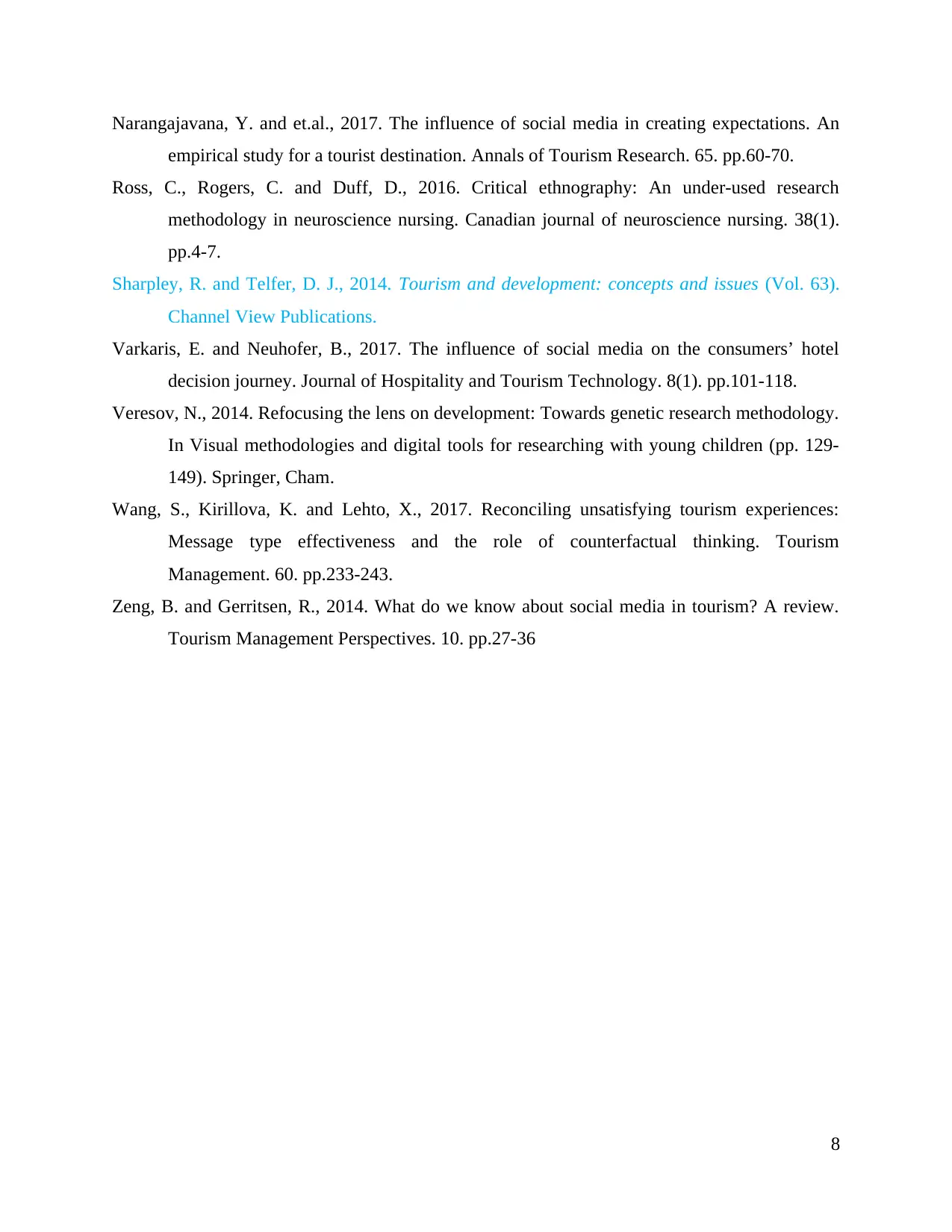
Narangajavana, Y. and et.al., 2017. The influence of social media in creating expectations. An
empirical study for a tourist destination. Annals of Tourism Research. 65. pp.60-70.
Ross, C., Rogers, C. and Duff, D., 2016. Critical ethnography: An under-used research
methodology in neuroscience nursing. Canadian journal of neuroscience nursing. 38(1).
pp.4-7.
Sharpley, R. and Telfer, D. J., 2014. Tourism and development: concepts and issues (Vol. 63).
Channel View Publications.
Varkaris, E. and Neuhofer, B., 2017. The influence of social media on the consumers’ hotel
decision journey. Journal of Hospitality and Tourism Technology. 8(1). pp.101-118.
Veresov, N., 2014. Refocusing the lens on development: Towards genetic research methodology.
In Visual methodologies and digital tools for researching with young children (pp. 129-
149). Springer, Cham.
Wang, S., Kirillova, K. and Lehto, X., 2017. Reconciling unsatisfying tourism experiences:
Message type effectiveness and the role of counterfactual thinking. Tourism
Management. 60. pp.233-243.
Zeng, B. and Gerritsen, R., 2014. What do we know about social media in tourism? A review.
Tourism Management Perspectives. 10. pp.27-36
8
empirical study for a tourist destination. Annals of Tourism Research. 65. pp.60-70.
Ross, C., Rogers, C. and Duff, D., 2016. Critical ethnography: An under-used research
methodology in neuroscience nursing. Canadian journal of neuroscience nursing. 38(1).
pp.4-7.
Sharpley, R. and Telfer, D. J., 2014. Tourism and development: concepts and issues (Vol. 63).
Channel View Publications.
Varkaris, E. and Neuhofer, B., 2017. The influence of social media on the consumers’ hotel
decision journey. Journal of Hospitality and Tourism Technology. 8(1). pp.101-118.
Veresov, N., 2014. Refocusing the lens on development: Towards genetic research methodology.
In Visual methodologies and digital tools for researching with young children (pp. 129-
149). Springer, Cham.
Wang, S., Kirillova, K. and Lehto, X., 2017. Reconciling unsatisfying tourism experiences:
Message type effectiveness and the role of counterfactual thinking. Tourism
Management. 60. pp.233-243.
Zeng, B. and Gerritsen, R., 2014. What do we know about social media in tourism? A review.
Tourism Management Perspectives. 10. pp.27-36
8
1 out of 10
Related Documents
Your All-in-One AI-Powered Toolkit for Academic Success.
+13062052269
info@desklib.com
Available 24*7 on WhatsApp / Email
![[object Object]](/_next/static/media/star-bottom.7253800d.svg)
Unlock your academic potential
Copyright © 2020–2025 A2Z Services. All Rights Reserved. Developed and managed by ZUCOL.



